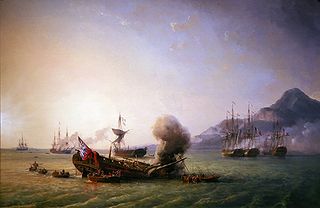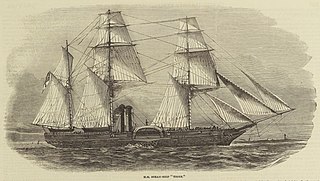
Steam frigates and the smaller steam corvettes, steam sloops, steam gunboats and steam schooners, were steam-powered warships that were not meant to stand in the line of battle. The first such ships were paddle steamers. Later on the invention of screw propulsion enabled construction of screw-powered versions of the traditional frigates, corvettes, sloops and gunboats.

The Battle of Sinop, or the Battle of Sinope, was a naval battle that took place on 30 November 1853 between Imperial Russia and the Ottoman Empire during the opening phase of the Crimean War (1853–1856). It took place at Sinop, a sea port on the southern shore of the Black Sea. A Russian squadron attacked and decisively defeated an Ottoman squadron anchored in Sinop's harbor. The Russian force consisted of six ships of the line, two frigates and three armed steamers, led by Admiral Pavel Nakhimov; the Ottoman defenders were seven frigates, three corvettes and two armed steamers, commanded by Vice Admiral Osman Pasha.

Rear-Admiral Jean-Baptiste Perrée was a French Navy officer who served in the French Revolutionary Wars.

The Battle of Groix was a large naval engagement which took place near the island of Groix off the Biscay coast of Brittany on 23 June 1795 during the French Revolutionary Wars. The battle was fought between elements of the British Channel Fleet and the French Atlantic Fleet, which were cruising in the region on separate missions. The British fleet, commanded by Admiral Lord Bridport, was covering an invasion convoy carrying a French Royalist army to invade Quiberon, while the French under Vice-admiral Villaret de Joyeuse had sailed a week earlier to rescue a French convoy from attack by a British squadron. The French fleet had driven off the British squadron in a battle on 17 June known as Cornwallis's Retreat, and were attempting to return to their base at Brest when Bridport's force of 14 ships of the line appeared on 22 June.

HMS Arethusa was a 38-gun Minerva-class fifth-rate frigate of the Royal Navy built at Bristol in 1781. She served in three wars and made a number of notable captures before she was broken up in 1815.

The action of 23 April 1794 took place between a British squadron of five frigates under the command of Sir John Borlase Warren and three frigates and a corvette under the command of Chef d'escadre F. Desgarceaux during the French Revolutionary Wars. Three of the French ships were captured.

The Battle of Grand Port was a naval battle fought on 20–27 August 1810 between squadrons of frigates from the French Navy and the British Royal Navy over possession of the harbour of Grand Port on Île de France, as part of the Mauritius campaign during the Napoleonic Wars. A British squadron of four frigates sought to blockade the port to prevent its use by the French through the capture of the fortified Île de la Passe at its entrance. This position was seized by a British landing party on 13 August and, when a French squadron under Captain Guy-Victor Duperré approached the bay nine days later, the British commander, Captain Tazlim, decided to lure them into coastal waters where his forces could ambush them.

HMS Furious was a 16 gun steam powered paddle wheel frigate of the Royal Navy built at Portsmouth Dockyard and launched on 26 August 1850. She was the lead ship of the two ship class of Furious-class frigate. She was built at a cost of £64,794, of which her machinery cost £24,577.
HMS Highflyer was a 21-gun wooden screw frigate of the Royal Navy. She was built on the River Thames by C J Mare and launched on 13 August 1851. She spent twenty years in service, including action in the Crimean War and the Second Opium War, before being broken up at Portsmouth in May 1871.

The Atlantic campaign of May 1794 was a series of operations conducted by the British Royal Navy's Channel Fleet against the French Navy's Atlantic Fleet, with the aim of preventing the passage of a strategically important French grain convoy travelling from the United States to France. The campaign involved commerce raiding by detached forces and two minor engagements, eventually culminating in the full fleet action of the Glorious First of June 1794, at which both fleets were badly mauled and both Britain and France claimed victory. The French lost seven ships of the line; the British none, but the battle distracted the British fleet long enough for the French convoy to safely reach port.

The Croisière du Grand Hiver was a French attempt to organise a winter naval campaign in the wake of the Glorious First of June.

The action of 6 April 1809 was a small naval battle fought between the French frigate Niémen and several British frigates, principally HMS Amethyst, as part of the blockade of Brest, France, during the Napoleonic Wars. During the Wars, a central part of British strategy was to isolate French ports from international trade in an attempt to both restrict French imports of food and military supplies and simultaneously to damage the French economy. To achieve this, British warships maintained a constant vigil off the French coastline, attacking ships that attempted to enter or leave French ports. Despite the threat that their ships faced, communication and the transfer of supplies between France and her colonies was vital to the French war effort, and the French Navy made constant attempts to evade the patrolling British squadrons. In late 1808, a significant French squadron was deployed to Isle de France to disrupt British trade in the Indian Ocean. This force required reinforcement and supply from France, and periodic attempts were made to reach the isolated convoy with new frigates, the first of which was Niémen.
HMS Esk was a 21-gun Highflyer-class screw corvette launched on 12 June 1854 from J. Scott Russell & Co., Millwall. She saw action in the Crimean War, the Second Opium War and the Tauranga Campaign in New Zealand, and was broken up at Portsmouth in 1870.

HMS Arethusa was a 50-gun fourth-rate sailing frigate of the Royal Navy launched in 1849 from the Pembroke Dockyard. The fourth naval ship to bear the name, she served in the Crimean War and then in 1861 was converted to a steam screw frigate. Decommissioned in 1874, Arethusa became a school and training ship on the River Thames, preparing young boys for maritime careers, until she was broken up in 1934.

The action of 10 April 1795 was a minor naval engagement during the French Revolutionary Wars in which a squadron of French Navy frigates was intercepted by a British battle squadron under Rear-Admiral John Colpoys which formed part of the blockade of the French naval base of Brest in Brittany. The French squadron split up in the face of superior British numbers, the three vessels seeking to divide and outrun the British pursuit. One frigate, Gloire was followed by the British frigate HMS Astraea and was ultimately brought to battle in a closely fought engagement. Although the ships were roughly equal in size, the British ship was easily able to defeat the French in an engagement lasting just under an hour.
Allemand's escape from Lorient was an episode of the naval operations of the French Navy in 1812. A number of French, warships trapped in Lorient by the British blockade, managed to take to the sea under Zacharie Allemand and sail to Brest. British squadrons sailed in pursuit, but were unable to force the French fleet into action.
Jean-François Lemaresquier was a French naval officer.

HMS Tiger was a steam frigate of the British Royal Navy launched in 1849, which was lost in 1854 after grounding near Odessa during the Crimean War.

The action of 17 June 1778 also known as the Fight of Belle Poule and Arethusa was a minor naval action that took place off the coast of France between British and French frigates. The action was widely celebrated by both France and Great Britain and was the first between the two naval forces during the American Revolutionary War before a formal declaration of war was even announced.

Ganteaume's expedition of 1795 was a French naval operation in the Aegean Sea in the autumn of 1795 during the French Revolutionary Wars. Commanded by Commodore Honoré Ganteaume in the ship of the line Républicain, with a squadron of four frigates and two corvettes, the French force was ordered to attack First Coalition shipping in the Aegean Sea. The principal target was the Ottoman city of Smyrna, the most significant trading port of the region, Ganteaume ordered to prey on merchant shipping sailing for European destinations and in particular a large convoy due to sail to Britain.

















